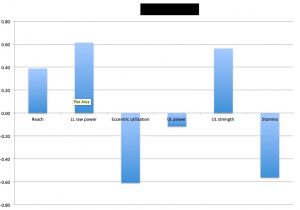The highlight of Tokyo’s social calendar is undoubtably Executive Fight night (EFN), a white collar boxing event held annually by the Ginja Ninjas (www.executivefightnight.com). At Club 360 we get to see the see the participants as they go through their gruelling 3-month training camp in preparation for the event.
This year we thought we would do something a little different and put the participants through a very basic physical testing battery to gain an idea of how they compare to each other in terms of physical characteristics.
As we were testing a large number (28) of participants and with limited resources, we selected tests that were simple and time-effective to conduct. These tests were
- Grip test (upper limb strength)
- Seated medicine ball toss (upper limb power)
- Squat jump (lower limb power)
- Countermovement jump (lower limb power)
- 2 minute modified burpee test (stamina – aerobic and anaerobic capacity)
Grip test
Whilst not necessarily specific to boxing, measures of grip strength correlate well with other basic strength measures, take only seconds to perform, and don’t require any previous experience with the testing procedure.
Seated medicine ball toss
In this test the athlete sits with their back against the wall and throws a 2kg medicine ball as far forward as possible. The results of this rest provide us with an idea of potential upper body contribution to punching power production.
Squat jump & countermovement jump
We used 2 versions of the vertical jump test, measured using the chronojump jump mat (https://vimeo.com/312507236). These measures provided information regarding the potential lower body contribution to punching power production. The squat jump measures jump height following a pause at the bottom of the movement, whereas the countermovement jump measures jump height without the pause. The difference between the two gives us some insight into how an athlete is producing force and how well they transition from eccentric (lengthening) to concentric (shortening) contractions. This is known as the eccentric utilisation ratio. Further information on the eccentric utilisation ratio may be found in a previous post (https://www.thescienceofstriking.com/training/what-does-you-testing-battery-look-like-part-4-power-assessments-part-2/)
2 minute modified burpee test
As the participants will be fighting over three 2-minute rounds, we decided to test their metabolic capacity in a 2-minute all-out effort. Burpees were performed without the push-up to minimise the risk of shoulder injury for those not accustomed to the task.
After collecting this data, the athletes scores were tabulated and compared against each other with the use of z-scores. As well as the physical tests described above, we also included relative reach (reach compared to height). Although not a modifiable characteristic, we felt that it would be interesting to to note if this also was predictive of performance. A basic tutorial on how z-scores are calculated may be found here:
We then used these z-scores to build a physiological profile for each athlete, presented in the form of a bar graph. The simple process of creating z-scores from an excel sheet is covered in this brief tutorial:
The 3 examples from different athletes below illustrate their basic individual physiological profiles.



The goal of this testing was to 1) identify each athlete’s individual strengths and weaknesses should they wish to focus on these to improve their potential performance in the event, 2) perform a post-event analysis to see if any of these characteristics were predictive of victory in an amateur white-collar boxing event, and 3) illustrate how easy it is to collect and compare athlete data to influence programming.
Stay tuned for as after the event on May 31st we will analyse the results of the fights and ascertain whether any of these characteristics where predictive of success!
Coaches who have a pool of athletes of relatively similar levels should consider the use of this type of monitoring as a way of comparing athlete’s strengths and weaknesses, and tailor for individualised training interventions.
A full framework of physiological testing is featured in the science of striking, available in both hard-copy and kindle formats (https://www.amazon.com/Science-Striking-Comprehensive-Physical-Preparation/dp/1729586821/ref=sr_1_2?ie=UTF8&qid=1543575646&sr=8-2&keywords=The+Science+of+Striking+Sam+Gilbert)
#testing #assessment #thescienceofstriking #boxing #kickboxing #karate #shinkyokushin #kyokushin
